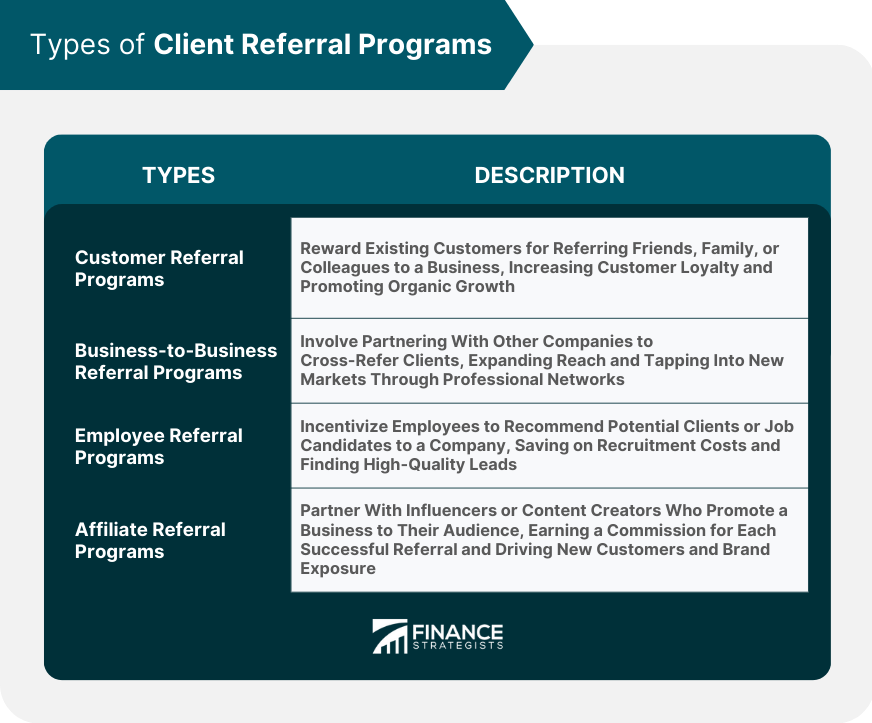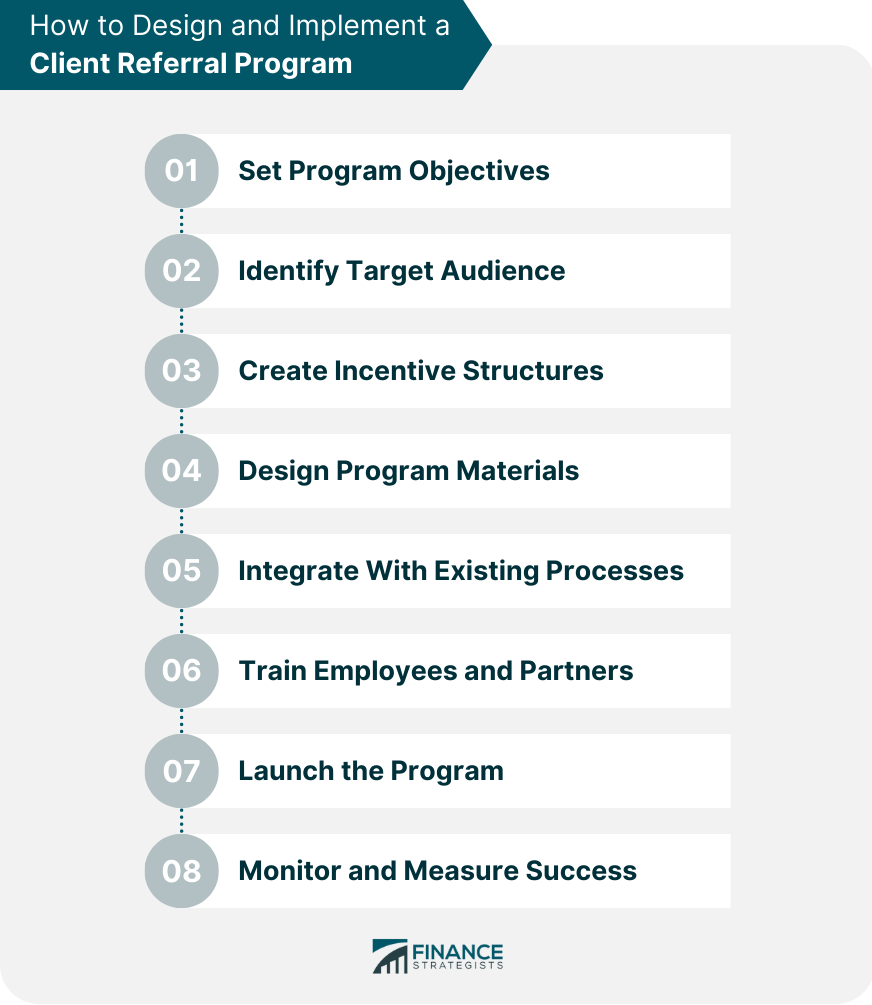A client referral program is a marketing strategy that incentivizes existing customers, partners, or employees to recommend a company's products or services to others. This word-of-mouth marketing approach can help businesses gain new clients and increase customer retention. The key to a successful client referral program is to offer incentives that motivate clients to participate actively. Incentives may include discounts, rewards, or exclusive offers for both the referrer and the referred. Client referral programs are essential because they leverage the trust established between existing clients and their networks. When a satisfied client recommends a business, the referred individual is more likely to trust and patronize that business, leading to increased sales and long-term growth. Different client referral program types cater to various business needs. This section will discuss customer referral programs, business-to-business referral programs, employee referral programs, and affiliate referral programs. Customer referral programs reward existing customers for referring friends, family, or colleagues to a business. These programs are effective in increasing customer loyalty and promoting organic growth. Business-to-business referral programs involve partnering with other companies to cross-refer clients. This type of program allows businesses to expand their reach and tap into new markets through professional networks. Employee referral programs incentivize employees to recommend potential clients or job candidates to a company. This approach can help businesses save on recruitment costs and find high-quality leads. Affiliate referral programs involve partnering with influencers or content creators who promote a business to their audience. In return, the affiliate earns a commission for each successful referral, driving new customers and increasing brand exposure. To create a successful client referral program, businesses must set objectives, identify their target audience, create incentive structures, and design program materials. Establishing clear objectives for a referral program helps businesses determine the program's focus and desired outcomes. Common objectives include increasing customer acquisition, boosting revenue, or enhancing brand awareness. Understanding the target audience for a referral program enables businesses to tailor their incentives and messaging. This ensures that the program appeals to the right clients, increasing the likelihood of successful referrals. Incentive structures can be monetary or non-monetary, depending on a business's goals and target audience. Monetary incentives might include discounts or cash rewards, while non-monetary incentives could involve exclusive benefits or recognition. Effective program materials, such as marketing collateral and referral request templates, help businesses communicate their referral program's value to clients. These materials should be visually appealing and easy to understand, encouraging participation. Proper implementation of a referral program involves integration with existing processes, employee training, program launch, and ongoing monitoring and measurement. Seamlessly integrating a referral program with existing business processes ensures efficiency and minimizes disruption. This may involve updating customer relationship management (CRM) systems or automating referral tracking. Educating employees and partners on the referral program's goals, incentives, and processes increases the likelihood of success. Training should emphasize the importance of referrals and provide clear instructions on program participation. A successful program launch requires promotion through various channels, such as email marketing, social media, and in-person events. This helps raise awareness and encourages participation among target audiences. Tracking key performance indicators (KPIs) and gathering qualitative feedback allows businesses to measure their referral program's success. This information helps identify areas for improvement and enables continuous optimization. To maximize the effectiveness of client referral programs, businesses should provide excellent customer service, develop long-term relationships, ensure clear and consistent communication, and leverage social media and online reviews. Exceptional customer service increases the likelihood of clients recommending a business to others. Satisfied customers become brand advocates, spreading positive word-of-mouth and driving new referrals. Building long-term relationships with clients, partners, and affiliates fosters trust and loyalty. This trust makes them more likely to refer new clients and contribute to a business's growth. Clear and consistent communication about the referral program, its benefits, and participation requirements encourages clients to take action. Regular updates and reminders can help maintain engagement and increase referral rates. Using social media platforms and online review sites to promote referral programs and showcase positive customer experiences can amplify the program's reach. This approach helps potential clients understand the value of a business's offerings and encourages them to become customers. To ensure ongoing success, businesses must analyze program performance, identify areas for improvement, implement changes, and continuously evaluate success. Monitoring KPIs and collecting qualitative feedback provides insights into a referral program's performance. This information helps businesses understand which aspects of the program are working well and which need improvement. By analyzing program performance, businesses can identify areas that require optimization. This might involve adjusting incentive structures, updating program materials, or refining messaging to better resonate with the target audience. Once areas for improvement are identified, businesses must implement changes and updates to the referral program. This ensures that the program remains effective and continues to drive growth. Regularly evaluating a referral program's success helps businesses stay agile and responsive to changes in customer behavior, market conditions, or business goals. Ongoing evaluation ensures that the program remains relevant and effective in driving new clients and revenue. A client referral program is a marketing strategy that incentivizes existing customers, partners, or employees to recommend a company's products or services to others, leveraging the trust established between existing clients and their networks. Different types of referral programs cater to various business needs, including customer referral programs, business-to-business referral programs, employee referral programs, and affiliate referral programs. To create and implement a successful client referral program, businesses must set objectives, identify their target audience, create incentive structures, design program materials, integrate with existing processes, train employees and partners, launch the program, and monitor and measure success. Best practices include providing excellent customer service, developing long-term relationships, ensuring clear and consistent communication, and leveraging social media and online reviews. Regular evaluation and optimization are also essential to ensure ongoing success. By following these guidelines, businesses can leverage their existing clients to drive new referrals, increase customer retention, and achieve long-term growth.What Are Client Referral Programs?
Types of Client Referral Programs
Customer Referral Programs
Business-to-Business Referral Programs
Employee Referral Programs
Affiliate Referral Programs

Designing a Client Referral Program
Set Program Objectives
Identify Target Audience
Create Incentive Structures
Design Program Materials
Implementing a Client Referral Program
Integrate With Existing Processes
Train Employees and Partners
Launch the Program
Monitor and Measure Success

Best Practices for Client Referral Programs
Providing Excellent Customer Service
Developing Long-Term Relationships
Ensuring Clear and Consistent Communication
Leveraging Social Media and Online Reviews
Evaluating and Optimizing Client Referral Programs
Analyzing Program Performance
Identifying Areas for Improvement
Implementing Changes and Updates
Continuously Evaluating Success
Conclusion
Client Referral Programs FAQs
A client referral program is a marketing strategy that incentivizes current customers to refer new customers to a business.
A client referral program can increase customer loyalty, improve brand awareness, and bring in new business at a lower cost.
Common types of client referral programs include cash rewards, discounts, and exclusive access to products or services.
To create an effective client referral program, you should define clear referral incentives, communicate the program to customers, and track the results to optimize performance.
To measure the success of your client referral program, you can track metrics such as the number of referrals generated, the conversion rate of referrals, and the lifetime value of referred customers.
True Tamplin is a published author, public speaker, CEO of UpDigital, and founder of Finance Strategists.
True is a Certified Educator in Personal Finance (CEPF®), author of The Handy Financial Ratios Guide, a member of the Society for Advancing Business Editing and Writing, contributes to his financial education site, Finance Strategists, and has spoken to various financial communities such as the CFA Institute, as well as university students like his Alma mater, Biola University, where he received a bachelor of science in business and data analytics.
To learn more about True, visit his personal website or view his author profiles on Amazon, Nasdaq and Forbes.















